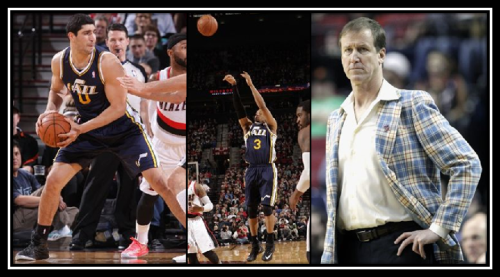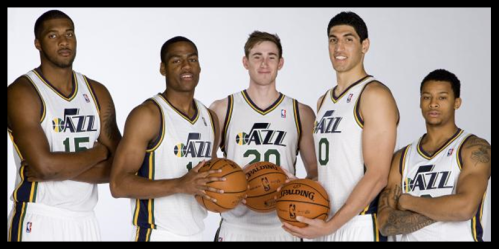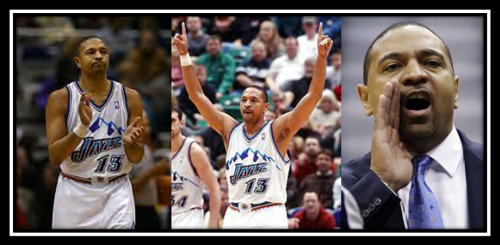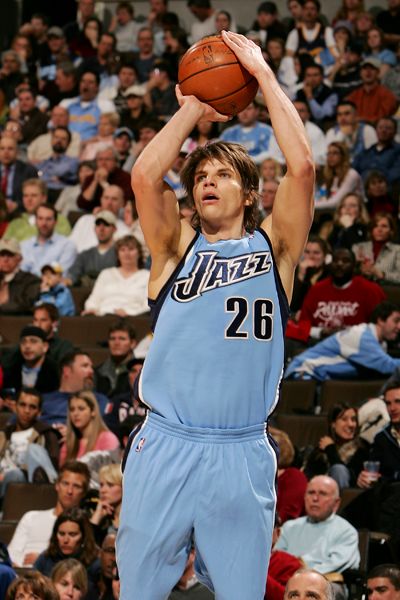The Utah Jazz are unquestionably a worse team on July 8th than they were on June 30th. Barring an unforeseen circumstance, they will be a worse team in 2017-18 than they were in 2016-17. The Jazz lost their best player, but they did not lose their most valuable one. There’s a difference, and that difference will stabalize the franchise for the next 4 years.
An organization’s most valuable player and leader imposes his will on his team’s style of play. The 2016-17 Utah Jazz battled through injuries to win 51 games and advanced to the NBA’s second round as a top-notch defensive-minded group that suffocated teams defensively and on the boards while scoring and executing efficiently if not proficiently. That signature belongs more to the playing style of Rudy Gobert than the since departed Gordon Hayward.
It was Rudy who publicly called out his teammates with Utah mired in a 1-4 tailspin and fresh off a blowout loss in LA to their eventual 1st-round foe. It was Rudy who backed up those comments by immediately posting 20 points, 19 rebounds and 5 blocks to jumpstart a 7-2 finish entering the playoffs. And it was Rudy who led the Jazz in wins shares and finished in the NBA’s top-5 in both offensive and defensive efficiency ratings. The Jazz won’t need to undergo a significant transformation into Rudy’s team because they were already assimilating towards that even with Gordon Hayward.

It should also be said it was Hayward who carried the bulk of the load at the heaviest of times in the postseason – Game 5 & 7 road wins in LA in which he was the best player on either team and when Rudy battled foul trouble returning from injury. While Hayward may never be a #1 player on a championship team, losing a top 15-20 player at perhaps the NBA’s most important position significantly hurts Utah’s on-court product.
With Ricky Rubio flanked by lefties Joe Ingles and Rodney Hood, the Jazz will have no problems initiating their sets but will miss the luxury of getting the ball to Hayward on their 2nd and 3rd integration of screen-roll with the shot clock winding down. Teams will defend Gobert differently in screen-roll and show out less forcing Rubio to pull-up from mid-range or get into the paint (where Rubio’s also struggled converting) before dishing/kicking out.
Fortunately, Gobert has consistently advanced his offensive game from a 7-1 center who struggled catching and going straight up to a ferocious finisher rolling/diving to the rim to a cognizant passer capable of flashing nifty vision to look weakside and pass on the move. Another season of adaptation and growth offensively for #27 is not out of the question and surrounding Rubio/Gobert with shooting (Hood, Ingles, Joe Johnson?) should keep the lane open for Rubio to find Gobert at the rim.
The Jazz will miss Hayward’s ability to score off-the-bounce, his defensive rebounding when Utah went small, and newfound off-ball cutting abilities the most. While Quin Snyder’s system oft relied on Hayward in a leading role – the offense (not much different from the free-flowing ones most teams in today’s league run) did not revolve around him. Hayward had begun to show a developing post game to punish smaller defenders switching onto him and it would not be surprising if part of Boston’s pitch to Hayward revolved around ways Brad Stevens would get Gordon the ball in scoring position earlier in the shotclock (which would be more about stroking a player’s ego than anything wrong with Utah’s offense).
Perhaps more so than Stevens’ coaching, playing with an alpha dog personality in Isaiah Thomas will help relieve pressure off Hayward in terms of 4th-quarter scoring attention and most importantly providing selective leadership. Hayward was looked upon as a leader in Utah because he was the Jazz’s best and most prominant player, not because he consistently exhibited the leadership qualities championship contenders require. In Boston, Isaiah can set the tone and Hayward can pick his spots – and both Boston and Hayward should be all the better for it.
The move is not without risk for Gordon. In leaving his Salt Lake media bubble often devoid of criticism, he’s pushing a restart button and putting his NBA legacy on the line. By the time he was first-round fodder in Brooklyn, NBA fans quickly forgot how dominant and elite Deron Williams was in his Utah days. Hayward will also need to produce under the brightest lights on the biggest stages or else he too will suffer the same media pressure Deron felt in Brooklyn. If he doesn’t, he may find himself in Danny Ainge’s asset collection by the time he’s ready to opt-out as a 10-year vet with a Jayson Tatum or Jaylen Brown ready to assume stature as a new face of the franchise.
Utah has their own future to evaluate. Surrounding Rudy, Ingles and Rubio – the Jazz have several veterans (Johnson, Favors, Burks) who (if healthy) are talented enough to play major roles and contribute to a playoff push. They also have a slew of younger players (Exum, Hood, and Mitchell) who they’d also be best served to give extended minutes to in order to properly evaluate and project their fit into the organization’s vision moving forward. Whether the Jazz ultimately toe the middle ground or shift their plans towards one of those groups will depend on how the first 3 months of the regular season goes but it’s worth mentioning a couple of those veterans also represent expiring contracts who could net a valuable asset that someone (a contender looking to bolster a playoff push or big-market team looking to clear 2018 capspace) may be willing to part with at the deadline as cap space gradually becomes a premium across the league.
From a business standpoint, the Jazz feel pressure to win. They’ve invested heavily in player and facility improvement and are depending on an income boost (raised ticket prices and enhanced club/box seating in addition to the NBA’s TV money) that is reliant upon winning games. Fans would rather buy tickets to sit on green hard plastic seats to watch a winner than black cushioned seats watching a loss. With a fanbase both reeling and galvanized by Hayward’s departure, this is one of the rare occurrences a drop back to a 7th/8th-seed would emotionally feel like a successful season. Finishing 9th or 10th in the ultra-competitive West isn’t out of the question either and given the inbalance between the two conferences, could result in a 1st-rnd pick as high as 9th or 10th.
One organization to both study and learn from would be the Portland Trailblazers sans LaMarcus Aldridge. Also a 51-win team in 2014-15, Aldridge’s departure paved the way for CJ McCollum to assume a starring role alongside Damian Lillard. While that dynamic duo is a bonafide big away from being a 55-win team – what’s locked Portland into NBA purgatory (44 and 41 wins the last two seasons) was overpaying on marginal role players. Allen Crabbe, Evan Turner, Mo Harkless, and Meyers Leonard each have 3 years left on their deals at an average salary of $14.4 million. Having over $56 million tied up in that foursome for 2017-18 was miscalculated.
Utah was right to re-sign Ingles but must be very meticulous in evaluating Hood and Exum’s next contract. Although the hope is there that Exum or Mitchell becomes a star and Hood a consistent scoring option – the Jazz need to view Rudy’s supporting cast with the mindset they’re a significant acquisition/trade away from getting back on track towards contention. With that approach – assets and flexibility are key.
The Jazz are good enough to win 36-46 games and fighting like hell to make the playoffs for the first three months with the option to pivot and trade a starter/rotation player for a future asset before the deadline would seem to be the most flexible approach that could provide a pleasing mix of internal development and immediate competitiveness.
Rudy Gobert is under contract until 2021 and the Jazz need to operate like they have a 3-4 year window to build a contender around him even if it means the worst-case scenario is passively missing the playoffs in year one. If they’re ahead of schedule and they’re right in the thick of things come February, all the better and standing pat could certainly make sense as well.
While the strategy for constructing an NBA contender varies between homebuilding and flipping houses, a hybrid model of both is necessary when you’re a small-market team already with a major piece in place.
The Jazz enter the new season with an offensive void but still with a foundation and future of options and hope. That’s what happens when you retain your most valuable player.

















